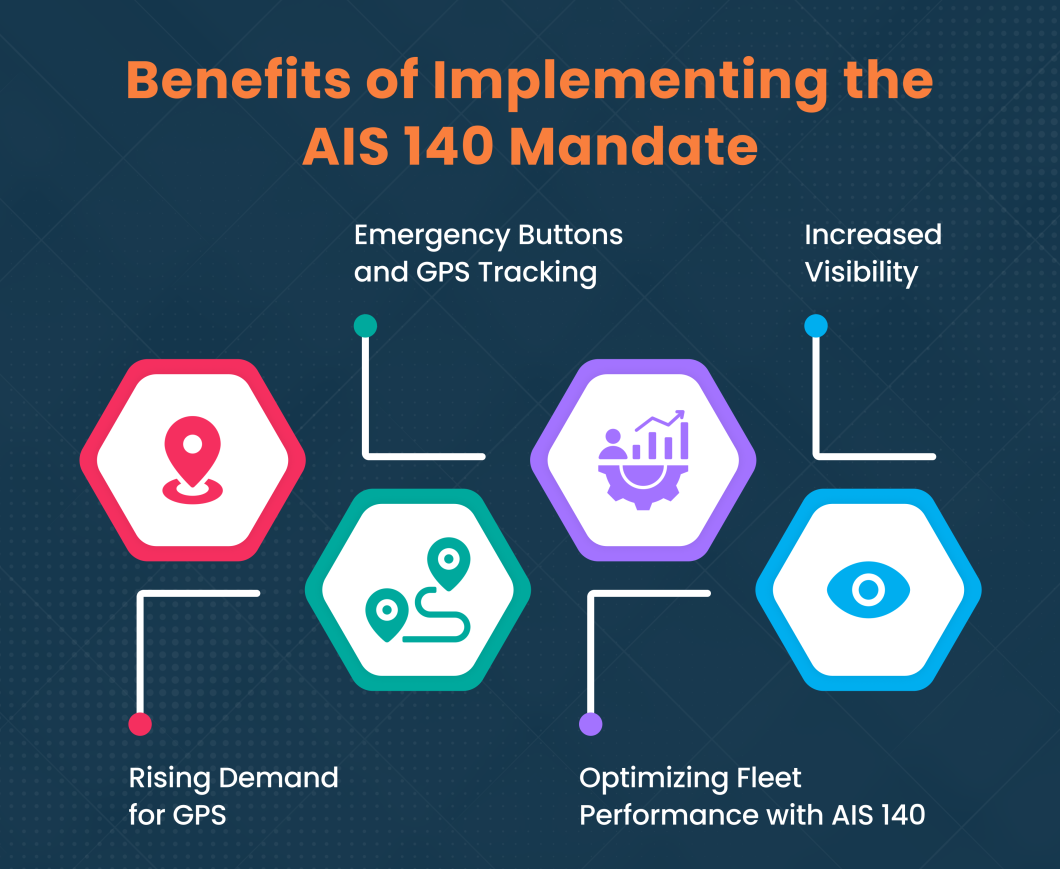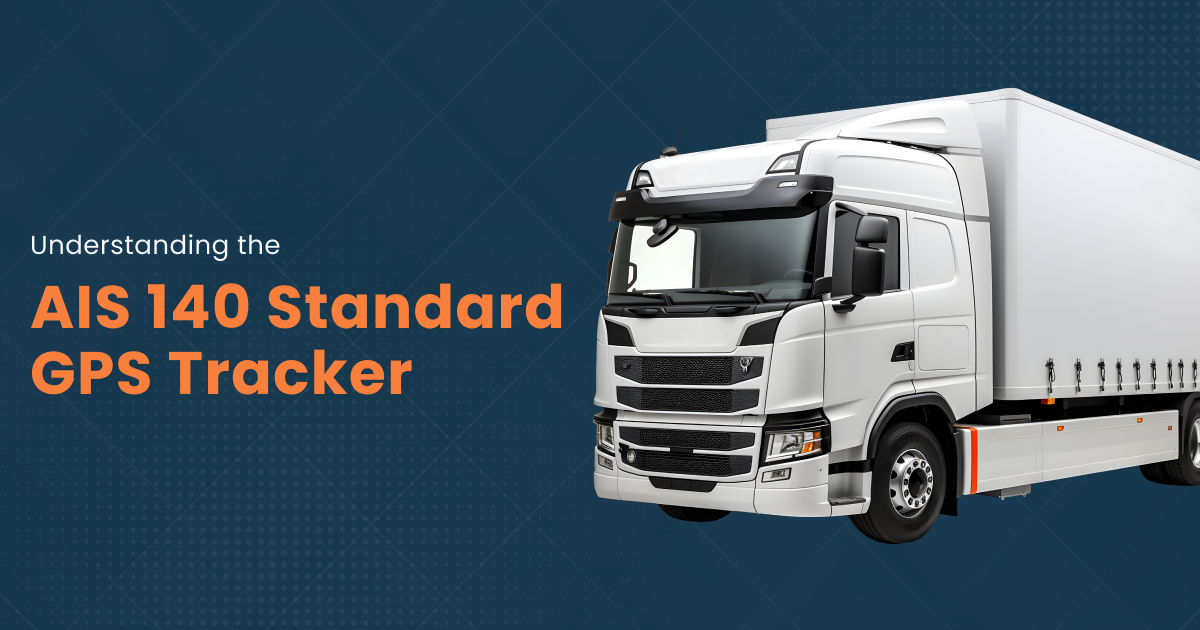The introduction of the AIS 140 GPS Tracker was one of the first steps to align with Intelligent Transportation System (ITS) standards.
In the past few years, the Indian government has made major efforts to enhance the transportation industry. Their goal is to bring Indian logistics up to global standards.
Since up to 35% of all road accidents involve buses, it truly feels essential, doesn’t it?
Not familiar with AIS 140? You’ve come to the right place for all the details. Before we delve into why this mandate exists, let’s first understand what these regulations actually involve.
Table of Contents
What is AIS 140? Why is it Mandatory?
AIS, which stands for Automotive Industry Standard, refers to regulations developed by the Automotive Industry Standard Committee (AISC) in partnership with the Ministry of Road Transport and Highways (MoRTH).
These guidelines aim to improve road safety and develop an intelligent transportation system. What specific rules do commercial vehicles need to follow under these regulations? They address several key aspects essential to the GPS tracking industry.
While the instructions under these mandates are highly detailed, here are the essential guidelines simplified for effective fleet management:
Hardware Compliance Guidelines under AIS 140
For the hardware, the ministry has established specific rules. Failing to comply with these rules can result in substantial fines and even the suspension of transport permits. The regulations concerning the hardware aspect of the system are as follows:
- Vehicles are required to utilize satellite modems, commonly known as GPS trackers, for transmitting information. Although many GPS systems rely on cellular data or SIM cards, these regulations specifically mandate the use of satellite modems.
- The GPS tracking device must have a minimum backup of 4 hours.
- Installing an emergency button in your vehicle is essential. It sends location data to two IP addresses: one to a government database and the other to an emergency support system.
- The device needs to have strong security features. It should be tamper-proof to prevent any incorrect data from entering the database. This ensures that the information sent during emergencies is always accurate and reliable.
AIS 140 Guidelines for Software
In addition to the hardware requirements, AIS 140 regulations include a detailed list of rules for the software used in GPS tracking. Some key software requirements are:
- When picking software to track your AIS 140-certified GPS device, compatibility is crucial. Ensure it connects easily with the trackers mentioned above for smooth operation.
- The system should do more than just track the vehicle’s location. It should also keep records of the vehicle’s performance, maintenance, and other important details.
- System managers should get emergency alerts. If the internet isn’t available, these alerts will be sent via SMS.
AIS 140 Requirements for Server Compliance
When it comes to storing the data from your GPS devices, the server or cloud service you use has a set of standards it must follow. These guidelines help make sure all fleet operations are safe and precise by being data-driven. Here’s a quick rundown of what these standards cover:
- Ensure your GPS tracking system has enough storage to keep vehicle data for at least 90 days, giving you a dependable record to look back on.
- Before granting access, please ensure that you verify the documents of both the vehicles and drivers. This extra step enhances security measures.
If you’re looking to implement AIS 140 in your fleet, contact us today for a free consultation!
When was the AIS 140 mandate enforced?
Since the mandate to install emergency buttons in all vehicles in 1989, the AIS 140 guidelines have made significant advancements. They now incorporate various new technologies to ensure safer roads.
In 2018, the guidelines developed over the years became mandatory for all public transportation buses. It wasn’t until April 2019 that these standards were applied to the entire public transport sector. However, these updates did not extend to private or commercial vehicles at that point.
From August 2022 onwards, the government has made AIS 140 mandatory for the commercial sector. This applies to all N2 and N3 vehicles, including those transporting hazardous goods. Manufacturers must fit GPS devices into new vehicle models by September 2022. Existing models also need to be updated to comply by January 2023.
Benefits of Implementing the AIS 140 Mandate
The adoption of AIS 140 regulations will make road travel safer and more efficient. However, fleet businesses might face a challenge: they’ll need to check if their current GPS tracking devices meet the new government standards. If not, they’ll have to invest in compliant devices, which could mean additional costs for upgrading their equipment.

1. Rising Demand for GPS: With these new guidelines affecting many sectors, there’s going to be a big increase in the need for GPS devices and software. This will lead to more connected vehicles on the roads. The forecast that 55% of all commercial trucks will be connected by 2025 now looks even more likely.
2. Safety Boost: Emergency Buttons and GPS Tracking Reduce Accidents:
Integrating emergency buttons in all public transportation vehicles enhances safety by lowering the chance of fatalities in accidents. Plus, maintaining vehicles well and using GPS tracking can significantly reduce accident rates. In fact, a study found that 42% of fleets using GPS tracking experienced fewer accidents.
3. Increased Visibility: Managing a large fleet can be challenging because it’s hard to keep track of all the vehicles. However, adding GPS makes it easy to see the location and activities of every vehicle, simplifying fleet management.
4. Optimizing Fleet Performance with AIS 140:
The AIS 140 regulation highlights the importance of keeping vehicles in good condition and promoting safe driving habits. This encourages fleets to look beyond just tracking their vehicles’ locations and focus on overall optimization of their fleet.
How Fleet Management Software Supports AIS 140 Implementation in India
When we think about a fleet management system, its main goal is to make sure fleet businesses run smoothly and efficiently. The software, which is a key part of the system, helps managers focus on different aspects of their fleets’ operations and fix any problems they come across.
Data is crucial in this process. Fleet businesses need to understand issues before they can address them effectively. Our fleet management software not only assists businesses in planning their fleet operations but also ensures compliance with AIS 140 regulations. Here are some ways it helps achieve this:
- Device Compatibility: Our software supports a wide range of protocols, ensuring compatibility with various GPS trackers. You can switch to different tracker types without needing to modify the software. Additionally, we offer the option to integrate an emergency button in your vehicle for added security when needed.
- Versatile Solution: Our software offers a variety of features that help businesses make lasting improvements to their fleets. These tools not only enhance safety but also ensure vehicles stay in peak condition, boosting profitability. It’s a perfect match for your fleets and our system!
- Keeps Track of History: To optimize your fleet, it’s crucial to know its challenges. Our system records vehicle activities for up to six months, exceeding the typical 90-day requirement. This information helps managers identify fleet weaknesses and make targeted improvements.
- Personalized Alerts: Our software solutions let fleet businesses pick the alerts they want to receive. These alerts help managers take quick action during emergencies.
AIS 140 Standard GPS Tracker: Elevating Fleet Management
The AIS 140 GPS tracker from HashStudioz Technologies is designed to meet the stringent standards set by the Automotive Research Association of India (ARAI) for commercial vehicles. This state-of-the-art device offers real-time tracking, an emergency alert system with a panic button, geo-fencing, and remote immobilization. With features like driver behavior monitoring, data logging, and easy installation, it ensures enhanced security, improved efficiency, regulatory compliance, and heightened safety for fleet operations. Its robust build and extensive functionalities make it a reliable choice for fleet management.
For more details, visit HashStudioz AIS 140 GPS Tracker.
Conclusion
By adopting AIS 140, fleet businesses can move towards automation. The features we’ve mentioned are just the beginning of what fleet management software can achieve. It helps businesses reduce operational costs and boost productivity significantly.
Each fleet is unique, with its own specific operations and requirements. That’s why our system offers customizable solutions tailored to your needs. With the mandate now a permanent part of the landscape, why not take the opportunity to explore our system and its features firsthand?

